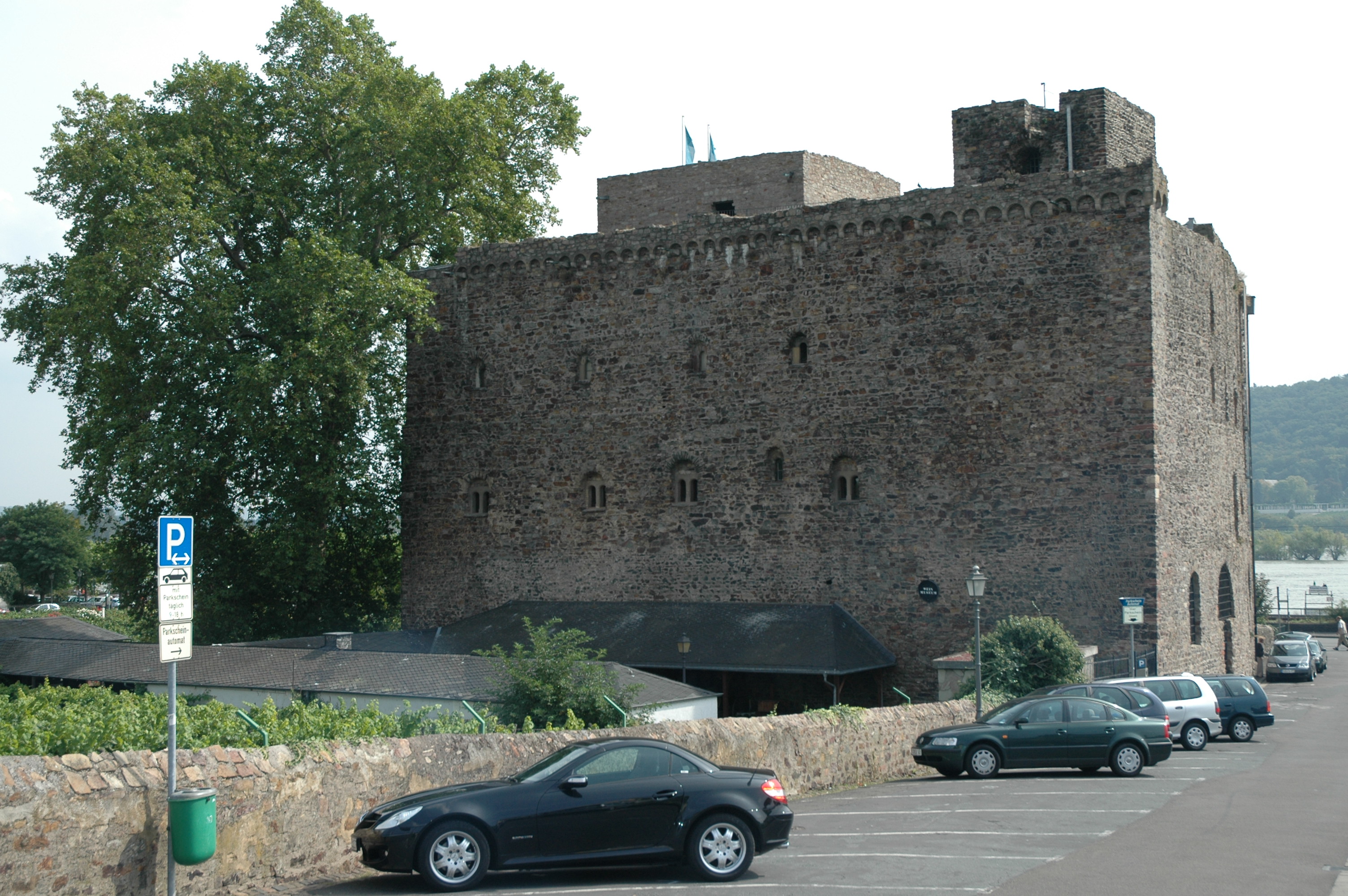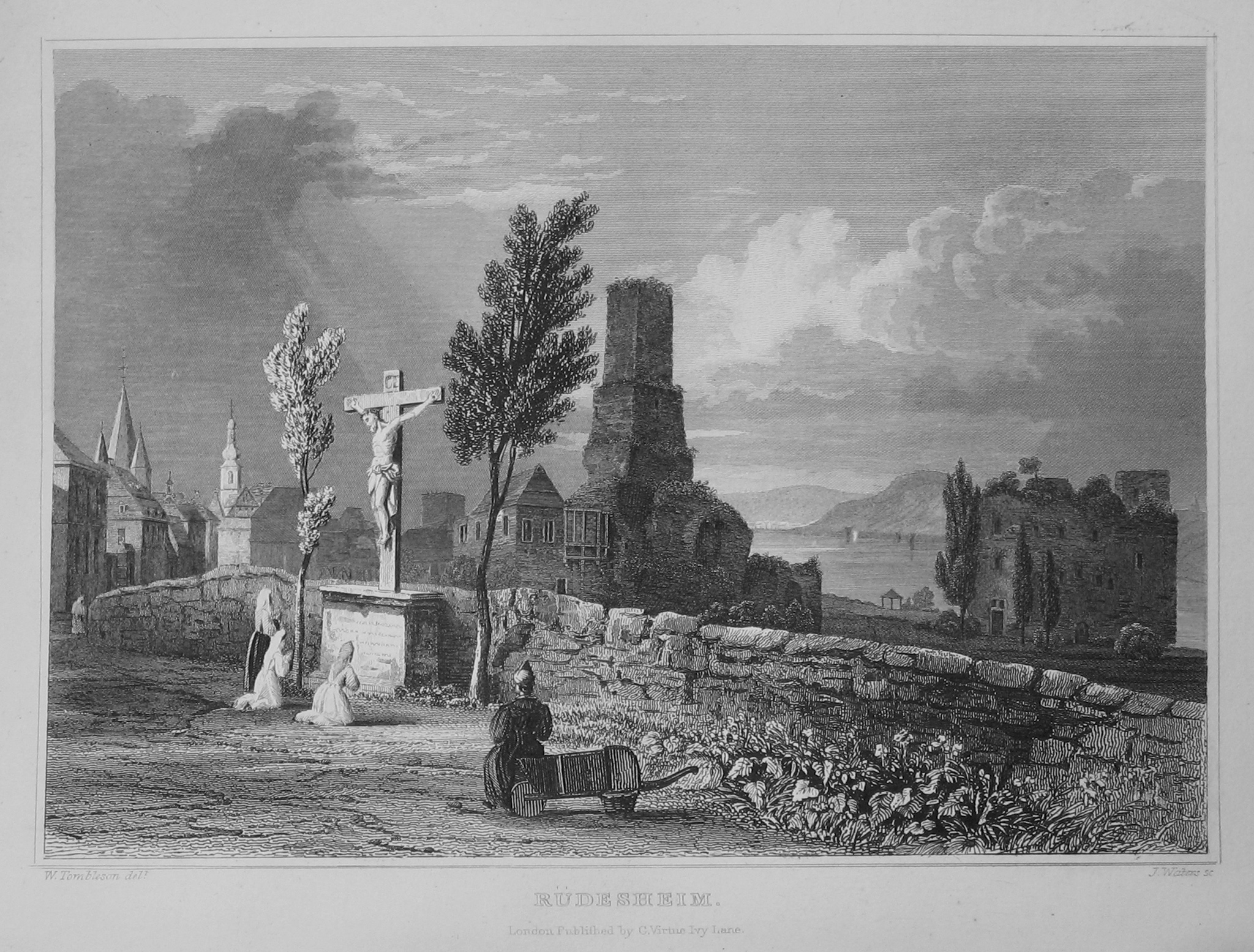Brömserburg on:
[Wikipedia]
[Google]
[Amazon]
 The Brömserburg (also called the ''Niederburg'') is located near the banks of the
The Brömserburg (also called the ''Niederburg'') is located near the banks of the
 In the 13th century, the family of Brömser from the Wisper valley are recorded as castellans (''Burgherren'') of the castle within the territory of the archbishops of Mainz.
In 1640, the south-eastern corner, facing the Rhine, was blown up by French troops of Duke Henry II of Orleans during the
In the 13th century, the family of Brömser from the Wisper valley are recorded as castellans (''Burgherren'') of the castle within the territory of the archbishops of Mainz.
In 1640, the south-eastern corner, facing the Rhine, was blown up by French troops of Duke Henry II of Orleans during the
The Brömserburg at rheinreise.de
The Brömserburg in the Rheingau
{{DEFAULTSORT:Bromserburg 12th-century architecture Middle Rhine Heritage sites in Hesse Buildings and structures in Rheingau-Taunus-Kreis Rheingau
Rhine
), Surselva, Graubünden, Switzerland
, source1_coordinates=
, source1_elevation =
, source2 = Rein Posteriur/Hinterrhein
, source2_location = Paradies Glacier, Graubünden, Switzerland
, source2_coordinates=
, so ...
in the town of Rüdesheim am Rhein
Rüdesheim am Rhein is a German winemaking town in the Rhine Gorge, and part of the UNESCO World Heritage Site in this region. It lies in the Rheingau-Taunus-Kreis district in the ''Regierungsbezirk'' of Darmstadt, Hessen. Known as Rüdesheim, i ...
in Rheingau-Taunus-Kreis
Rheingau-Taunus is a Kreis (district) in the west of Hesse, Germany. Rheingau-Taunus-Kreis is part of the Darmstadt region; its main administrative seat is Bad Schwalbach. Outposted sections of the local administration are located in Idstein and R ...
in the German state of Hesse
Hesse (, , ) or Hessia (, ; german: Hessen ), officially the State of Hessen (german: links=no, Land Hessen), is a state in Germany. Its capital city is Wiesbaden, and the largest urban area is Frankfurt. Two other major historic cities are Dar ...
. Its original structure was probably one of the first stone castles in the Rhine Gorge
The Rhine Gorge is a popular name for the Upper Middle Rhine Valley, a 65 km section of the Rhine between Koblenz and Rüdesheim in the states of Rhineland-Palatinate and Hesse in Germany. It was added to the UNESCO list of World Heritage S ...
, now a UNESCO World Heritage Site.
Construction
The older literature (from the 19th century to the 1980s) suggested the Brömserburg was built on the foundations of a Roman fort. However, no antique building fabric has been confirmed and, in particular, it remains unproven that, as previously assumed, it was a watchtower or the bridgehead of a crossing opposite '' Bingium'' (Bingen am Rhein
Bingen am Rhein () is a town in the Mainz-Bingen district in Rhineland-Palatinate, Germany.
The settlement's original name was Bingium, a Celtic word that may have meant "hole in the rock", a description of the shoal behind the ''Mäuseturm'', k ...
) on the left bank of the Rhine. Since this fort was only built in the 4th century, the thesis is not conclusive, because the Romans
Roman or Romans most often refers to:
*Rome, the capital city of Italy
* Ancient Rome, Roman civilization from 8th century BC to 5th century AD
*Roman people, the people of ancient Rome
*''Epistle to the Romans'', shortened to ''Romans'', a lette ...
had already withdrawn from the right bank of the Rhine after the fall
Autumn, also known as fall in American English and Canadian English, is one of the four temperate seasons on Earth. Outside the tropics, autumn marks the transition from summer to winter, in September (Northern Hemisphere) or March ( Southe ...
of the limes
Limes may refer to:
* the plural form of lime (disambiguation)
Lime commonly refers to:
* Lime (fruit), a green citrus fruit
* Lime (material), inorganic materials containing calcium, usually calcium oxide or calcium hydroxide
* Lime (color), a ...
.
Two construction phases are identifiable. Researchers do not agree on the dating of the first phase, theories ranging from an early medieval, royal '' Salhof'', dating to before 980, to a mid-12th century castle complex. Examination of an alder post from the foundation of the southeast tower, which is considered to be the oldest part of the castle, showed that the tower could not have been built before 1044 and not after 1216.Proceedings of the General Assembly of the Rheingau Wine Museum, 29 September 2008; Result of the Investigation of a Pile made of Alder Wood from the Foundation of the Tower based on the C-14 Method. Unfortunately, a dendrochronological examination of the wood was not possible because it was a side shoot with only 11 annual rings
The end of the 12th century (1186-1190) was the final period of construction for the second castle.
The shape of the castle, even during its first construction phase, corresponded largely to its present dimensions. It was protected by an enceinte
Enceinte (from Latin incinctus: girdled, surrounded) is a French term that refers to the "main defensive enclosure of a fortification". For a castle, this is the main defensive line of wall towers and curtain walls enclosing the position. Fo ...
and moats; in those days the Rhine
), Surselva, Graubünden, Switzerland
, source1_coordinates=
, source1_elevation =
, source2 = Rein Posteriur/Hinterrhein
, source2_location = Paradies Glacier, Graubünden, Switzerland
, source2_coordinates=
, so ...
flowed, according to historical engravings, immediately past its southern front - unlike today, where there is a road and wide riverbank zone between the castle and the river. However, the enceinte was thinner (1.6-1.7 metres) and lower than it is today. In the southeast corner there used to be a tower house
A tower house is a particular type of stone structure, built for defensive purposes as well as habitation. Tower houses began to appear in the Middle Ages, especially in mountainous or limited access areas, in order to command and defend strateg ...
(donjon
A keep (from the Middle English ''kype'') is a type of fortified tower built within castles during the Middle Ages by European nobility. Scholars have debated the scope of the word ''keep'', but usually consider it to refer to large towers in ...
), now gone. The tower diagonally opposite, which has survived, also originates from this first phase and served to defend the gate (gate tower
A gate tower (german: Torturm) is a tower built over or next to a major gateway.
Usually it is part of a medieval fortification. This may be a town or city wall, fortress, castle or castle chapel. The gate tower may be built as a twin tower on ...
) as well as acting as a ''bergfried
''Bergfried'' (plural: ''bergfriede''; English: ''belfry''; French: ''tour-beffroi''; Spanish: ''torre del homenaje'') is a tall tower that is typically found in castles of the Middle Ages in German-speaking countries and in countries under Germ ...
''. At that time, its height reached up to the upper edge of the present fighting platform
A fighting platform or terraceKaufmann, J.E. and Kaufmann, H.W (2001). ''The Medieval Fortress'', Cambridge, Massachusetts, Da Capo, p. 29. . is the uppermost defensive platform of an ancient or medieval gateway, tower (such as the fighting platfor ...
.
During the second construction phase, the outer wall was reinforced, cladded with brick and raised. Other buildings were built onto the donjon up to the same height, and completely vaulted in up to four storeys (a unique design for a castle on the Rhine); thus a quadrangular structure was created. At the same time the courtyard was raised in height and, in the centre, a massive, new ''bergfried'' was erected which was joined onto adjacent elements of the second phase without any joints. Originally it had a wall thickness of more than 4 metres in the lower section and was estimated to be about 35 metres high. Due to the location of the entrance of the new ''bergfried'' - the elevated entrance is on the highest surviving floor) it is clear that the tower must have been much higher than it is today; it clearly rose above the adjoining buildings and thus gave the castle a much less "squat" appearance than it has today.
History
 In the 13th century, the family of Brömser from the Wisper valley are recorded as castellans (''Burgherren'') of the castle within the territory of the archbishops of Mainz.
In 1640, the south-eastern corner, facing the Rhine, was blown up by French troops of Duke Henry II of Orleans during the
In the 13th century, the family of Brömser from the Wisper valley are recorded as castellans (''Burgherren'') of the castle within the territory of the archbishops of Mainz.
In 1640, the south-eastern corner, facing the Rhine, was blown up by French troops of Duke Henry II of Orleans during the Thirty Years' War
The Thirty Years' War was one of the longest and most destructive conflicts in European history, lasting from 1618 to 1648. Fought primarily in Central Europe, an estimated 4.5 to 8 million soldiers and civilians died as a result of battle ...
, at the same time destroying the upper part of the ''bergfried'' and the donjon. A mine passageway was driven into the ''bergfried'', but there was no explosion. It is still visible today.
The popular assertion that the Brömser von Rüdesheim family lived in the castle from 1548 until they died out in 1668, is wrong. What really happened is that, after the main line of the Rüdesheim family died out on the death of Melchior von Rüdesheim in 1538, the Brömsers gradually took over the Rüdesheim fief. The Brömsers never actually lived there, but always resided in their own house, the ''Brömserhof'' in Oberstraße 29 in Rüdesheim. After the Brömsers died out, the Archbishop of Mainz granted the fiefdom to Emmerich of Metternich, an heir of the Brömser von Rüdesheim family, in 1678. As the castle remained uninhabited, it fell into ruin in the 18th century and was initially nicknamed "Brömser's dog house", and, later, "Metternich's dog house".
After 1811, the new owners - the counts of Ingelheim - undertook a romanticised expansion of the castle into a country house. In the south wing, these features were removed again in the 1950s during a renovation.
The castle was lived in until 1937. In 1941 it was bought by the town of Rüdesheim. Since 1950, it has housed the Rheingau Wine Museum with exhibits of wine culture from antiquity to the present day. In 1961, the destroyed south-east corner was reconstructed and, in 1969, the keep was raised to a height of 27 metres.
References
Literature
* Thomas Biller, Achim Wendt: ''Burgen im Welterbegebiet Oberes Mittelrheintal - Ein Führer zu Architektur und Geschichte''. 1st edition. Verlag Schnell & Steiner, Regensburg, 2013, , pp. 71–73. * Thomas Biller: ''Burgen im Taunus und im Rheingau - Ein Führer zu Geschichte und Architektur'' 1st edition. Verlag Schnell & Steiner, Regensburg, 2008, , pp. 91–95. * Michael Fuhr: ''Wer will des Stromes Hüter sein? 40 Burgen und Schlösser am Mittelrhein.'' 1st edition. Verlag Schnell & Steiner, Regensburg, 2002, . * Wolfgang L. Roser: ''Die Niederburg in Rüdesheim. Ein Befestigungsbau des Erzbistums Mainz im Rheingau''. In: Nassauische Annalen 101 (1990), pp. 7–29. * ''Kunsthistorischer Wanderführer Hessen.'' Stuttgart/Zurich, 1984. (still portrays its older condition)External links
*The Brömserburg at rheinreise.de
The Brömserburg in the Rheingau
{{DEFAULTSORT:Bromserburg 12th-century architecture Middle Rhine Heritage sites in Hesse Buildings and structures in Rheingau-Taunus-Kreis Rheingau